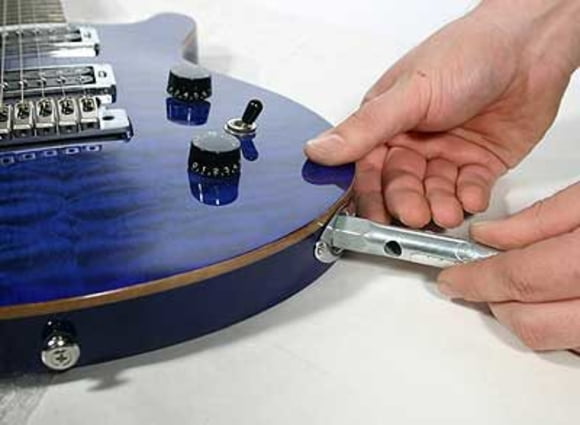10. Pots, switches and electronics
Potentiometers
Although guitar electronics are usually pretty simple and straight-forward, they too can become less dependable and cause trouble after some time. Luckily, in many cases you can get away without complex repairs. Scratchy pots can be brought back to life with a spray lubricant or contact spray, although this is just a temporary fix. Just spray into the enclosure of the potentiometer, turn the knob back and forth a few times and the noise should be gone. However, it's usually best to replace the pot the first time it causes problems, as the spraying only helps temporarily. Make sure to get a replacement part that matches the electrical values of the original part. Single coils are normally controlled with 250 kΩ pots, while most Humbuckers require 500 kΩ. The labels “linear” or “log(arithmic)” describe the characteristic of the potentiometer.
We carry a multitude of suitable potentiometers for various purposes (Volume, Tone, Humbucker, single coil). If you have some basic experience with soldering, replacing a pot yourself shouldn't be a problem.
Hint:
To avoid confusion while working on the electronics of a guitar, you should draw up a quick sketch of the original wiring before going to work. Or take a picture with your smartphone. If you're prepared like this, what could possibly go wrong?
Pickup selector switches
Like pots, selector switches can start to cause problems sooner than expected, depending on their quality and how much abuse they get. Noises and drop-outs aren't much fun. While switch oil can be a short-term remedy, in most cases you will need to replace the switch – especially if it causes the signal to drop out completely. And while you're at it, you might as well choose a high quality brand. You can find all kinds of replacement switches at our online store. From 3- and 5-position Fender-style switches to the typical 3-way toggle switch: You name it, we've got it.
Jack
If the plug of your guitar cable fits only loosely into the jack and seems to fall out during every ferocious pose on stage, you need to do something about it quickly. It's usually enough to take out the jack and mounting plate and adjust the tension of the holding flap by bending it inwards.
Hint:
To prevent the wires from coming loose, you should regularly check if the jack is mounted firmly, and fix it if it isn't. Every movement of the jack places mechanical stress on the solder joints, which can ultimately lead to failure. If the jack continues to cause trouble despite all your efforts, it may be time to replace it with a new one.

This is especially true for enclosed variants, where you cannot reach the internal components of the jack. Soldering the wires to a new jack isn't hard at all, and you'll be rewarded with peace of mind. We carry a wide range of spare parts – see for yourself!
Your Contacts
Product Highlights
-
Guitar Cleaning Products

